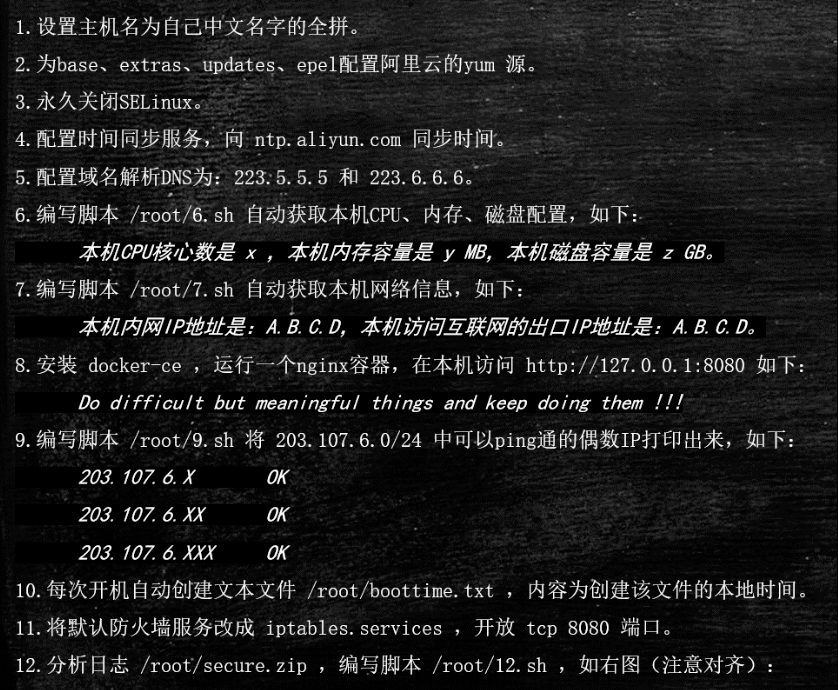task1 脚本

以下是为每个任务编写的脚本和配置步骤,基于最小化安装的 CentOS 7.9 系统:
任务 6:脚本 /root/6.sh
#!/bin/bash
cpu_cores=$(grep -c 'processor' /proc/cpuinfo)
mem_mb=$(free -m | awk '/Mem:/ {print $2}')
disk_gb=$(df -BG / | awk 'NR==2 {gsub("G","",$2); print $2}')
echo "本机CPU核心数是$cpu_cores,本机内存容量是$mem_mb MB,本机磁盘容量是$disk_gb GB。"
权限设置:
chmod +x /root/6.sh
任务 7:脚本 /root/7.sh
#!/bin/bash
internal_ip=$(ip route get 1 | awk '{print $NF;exit}')
external_ip=$(curl -s icanhazip.com)
echo "本机内网IP地址是:$internal_ip,本机访问互联网的出口IP地址是:$external_ip。"
权限设置:
chmod +x /root/7.sh
任务 8:安装 Docker 并运行 Nginx 容器
# 安装依赖
yum install -y yum-utils device-mapper-persistent-data lvm2
# 添加 Docker 仓库
yum-config-manager --add-repo https://download.docker.com/linux/centos/docker-ce.repo
# 安装 Docker
yum install -y docker-ce docker-ce-cli containerd.io
# 启动 Docker 服务
systemctl start docker
systemctl enable docker
# 创建自定义 HTML 文件
echo 'Do difficult but meaningful things and keep doing them !!!' > /root/index.html
# 运行 Nginx 容器
docker run -d --name mynginx -p 8080:80 -v /root/index.html:/usr/share/nginx/html/index.html nginx
验证:
curl http://127.0.0.1:8080 # 应返回自定义文本
任务 9:脚本 /root/9.sh
#!/bin/bash
network="203.107.6"
for ip in {2..254..2}; do
if ping -c 1 -W 1 "$network.$ip" &> /dev/null; then
echo "$network.$ip"
fi
done
权限设置:
chmod +x /root/9.sh
任务 10:开机自动创建 /root/boottime.txt
# 创建 systemd 服务
cat > /etc/systemd/system/boottime.service <<EOF
[Unit]
Description=Record boot time
[Service]
ExecStart=/bin/bash -c 'date +"%%Y-%%m-%%d %%H:%%M:%%S" > /root/boottime.txt'
[Install]
WantedBy=multi-user.target
EOF
# 启用服务
systemctl enable boottime.service
验证:
重启后检查 /root/boottime.txt 是否生成。
任务 11:配置 iptables 防火墙
# 停止并禁用 firewalld
systemctl stop firewalld
systemctl disable firewalld
# 安装 iptables
yum install -y iptables-services
# 启用 iptables
systemctl start iptables
systemctl enable iptables
# 开放 8080 端口
iptables -I INPUT -p tcp --dport 8080 -j ACCEPT
service iptables save
任务 12:日志分析脚本 /root/12.sh
假设需求是统计 /root/secure 中的登录失败记录(根据常见场景)
#!/bin/bash
log_file="/root/secure"
# 统计登录失败的IP和次数
grep "Failed password" "$log_file" | awk '{print $11}' | sort | uniq -c | sort -nr | while read count ip; do
printf "%-15s %-4s\n" "$ip" "$count"
done
权限设置:
chmod +x /root/12.sh
使用说明:
- 解压日志:
unzip /root/secure.zip -d /root - 运行脚本:
/root/12.sh - 输出格式示例:
192.168.1.10 12 10.0.0.5 5
验证所有任务
- 执行脚本
/root/6.sh、/root/7.sh、/root/9.sh检查输出。 - 访问
http://127.0.0.1:8080验证 Nginx 容器。 - 重启后检查
/root/boottime.txt。 - 运行
iptables -L -n确认 8080 端口开放。 - 解压日志后运行
/root/12.sh检查分析结果。
注意:
- 任务 12 的日志分析逻辑可根据实际需求调整(如修改
grep关键词)。- Docker 安装需联网,确保
curl icanhazip.com能获取公网 IP。- 所有脚本需赋予执行权限(
chmod +x /root/*.sh)。







 浙公网安备 33010602011771号
浙公网安备 33010602011771号